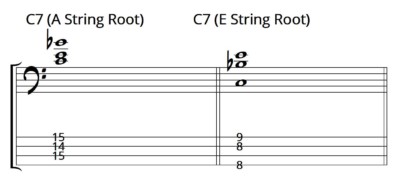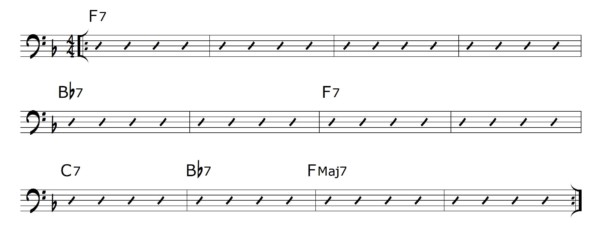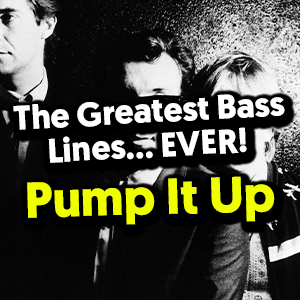In this lesson we’re looking at Tim Commerford’s bass line in the song Bullet In The Head by Rage Against The Machine including Bass Tabs and Drum Practice Tracks. This bass riff is a great example of how to use a dominant 7 chord in a conventional bass line.
Bullet In The Head Riff:
Practice Track:

Breakdown
Let’s have a look at some of the nuts and bolts of the theory behind this chord. The chord used in this riff is an E7. That’s an E dominant 7 chord.
To create a Dominant 7 chord we take a Major Triad and add a minor 7th. The Major Triad and Dominant 7 chord on a root of C are as follows:
- C Major : C E G
- C7: C E G Bb
Below you can see two very popular voicings for a C7 chord. One with a root note on the A string, the other with a root note on the E string:

The Missing 5th
Now you may be thinking to yourself, “Those chords aren’t right! They only have 3 notes!” and that’s correct.
Both of these voicings miss out the 5th. This is a common way of voicing chords on bass guitar and helps with applying the chord to 4 strings more easily. It also helps to clean up any muddiness we might find.
The 5th is the least essential of the notes in the chord and pretty much acts to bolster the root note. The root is obviously an important note and the 3rd and the 7th are the real character notes in there. So for our dominant 7 chords we have the root, the 3rd and the 7th. These work perfectly on bass guitar.
Dominant 7 Practice
I’d advise you to just play around with those chords for a while, getting them under your fingers. One great way to apply Dominant 7 chords is by playing through a basic blues progression. Many 12 bar blues progressions are made up of Dominant 7 chords exclusively.
Here is a simple 12 Bar Blues in F:

This progression makes use of the following chords:

Applying Dominant 7 Chords
Dominant 7 chords can be great for use in your bass lines especially when you isolate the upper Tritone. This is the interval between the 3rd and 7th. We call this a Tritone because the notes are three whole steps or tones apart. This interval has a really colourful sound and you can use it to really milk that dominant 7 sound.
The Tritone is also a symmetrical interval. If you play the notes in inversion we still have a tritone. So if we take the G# and D as our tritone within the E7 chord, we can play the notes elsewhere as D and G#. Both patterns can be seen as a Tritone.
The following riff features both Tritone patterns from the E7 chord:














Great lesson, thank you! As always using real life example to demonstrate a concept clearly, then expanding to more general stuff. That’s a great teaching approach IMO. I was just going through your “theory” section, and this one came as a great supplement to the “7th chords” part. Cheers, Adam.